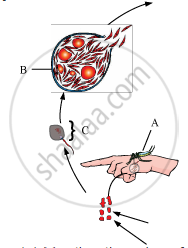Advertisements
Advertisements
प्रश्न
Study a part of the life cycle of malarial parasite given below. Answer the questions that follow:

(a) Mention the roles of ‘A’ in the life cycle of the malarial parasite.
(b) Name the event ‘C’ and the organ where this event occurs.
(c) Identify the organ ‘B’ and name the cells being released from it.
उत्तर
(a) A in the image represents the female mosquito. The female mosquito takes up the gametocytes of the malarial parasite along with the blood meal when it bites an infected person.
(b) The event 'C' is the fertilization stage and it takes place in the intestine of the mosquito.
(c) The organ 'B' is the salivary gland of the mosquito and the sporozoites escape out of the mosquito's salivary gland.
APPEARS IN
संबंधित प्रश्न
Name the causative organism of the disease amoebiasis. List three symptoms of the disease.
Persons suffering from sickle cell anaemia are at an advantage in Malaria infested areas. Explain .
Give one significant difference between Humoral immunity and cell-mediated immunity.
Exo-erythrocytic schizogony of Plasmodium takes place in ____________.
Recognition of an antigenic protein of a pathogen or exposure to a pathogen occurs during many types of immune responses, including active immunity and induced active immunity.
Specify the types of responses elicited when human beings get encountered by a pathogen.
Which of the following sets of diseases is caused by bacteria?
Which of the following viruses is not transferred through the semen of an infected male?
Ringworm in humans is caused by:
The alveoli (air filled sacs) of the lungs are infected in
How does the transmission of the following disease take place?
Pneumonia
